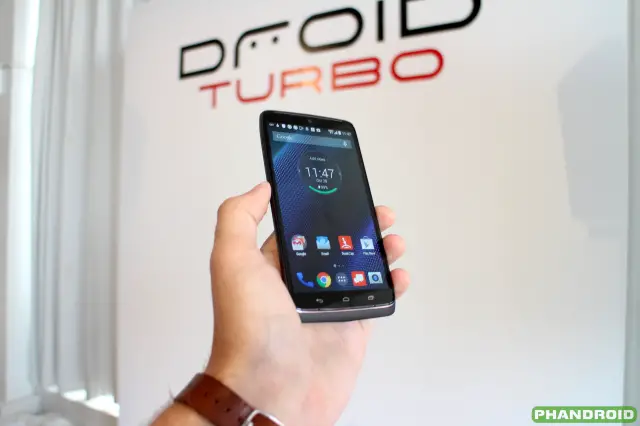Hands-on: Motorola Droid Turbo
Another year, another Droid. Despite turbulent times at Motorola the company remains dedicated to churning out Droid devices via their partnership with Verizon, but their strategy has shifted slightly. While previous years have seen a plethora of Droid-branded devices, 2014 brings us only one. The Motorola Droid Turbo comes in as the lineup’s new flagship. If first impressions mean anything, Moto and Verizon are off to a good start.
On paper the Droid Turbo has every means to dominate:
- a 5.2-inch Quad HD display,
- Qualcomm Snapdragon 805 SoC (Quad-Core @ 2.7GHz),
- 3GB RAM
- 21MP camera,
- and a 3900mAh battery.
As per that last spec, Motorola made a big point to emphasize the Turbo’s big battery. It’s not a spec we can truly test in our so-far limited hands-on time, but there are promises of 48 hours worth of battery life with an 8-hour boost attainable via only 15 minutes of charging thanks to Motorola’s Turbo Charge technology.
But I digress. The Droid Turbo lives up to the excellent build quality Motorola has come to be known for. Even better, the Turbo improves in some areas. A new ballistic nylon finish option makes for the most appealing version of the device (also available is a “metallized glass” finish in red or black). The fabric weave is this year’s alternative to the kevlar construction of previous Droid handsets, and it promises a similar level of durability while offering a unique feel and visual texture.
The device is by no means light in the hand, but it doesn’t feel overwhelming or uncomfortable. It’s a nice size and the weight is distributed evenly. Moto’s bezel game is again strong with the Turbo, allowing the 5.2-inch display to take up the majority of the handset’s front. We like what we’ve seen so far from that display. It’s as crisp and clear as any other Quad HD we have experienced and capable of some deep and rich colors.
The internal hardware of the Droid Turbo shouldn’t disappoint. Its Snapdragon 805 is the top of its class in terms of processing power and capabilities. The Droid Turbo will be among a select class of devices to feature the chip (the Nexus 6, a Motorola device that shares much of its DNA with the Turbo, also carries the Snapdragon 805 but won’t make it market until after the Verizon-exclusive Droid).

And it feels powerful flowing through homescreens and the usual sorts of surface-level tasks. It’s helped along by a “pure” Android install — much like the Moto X. For those wondering, yes, Motorola is promising an upgrade to Lollipop when available. Although our first impressions of the Droid Turbo’s hardware were positive overall, there is a bit of lag in some spots (notably the camera shutter).
As for how capable that 21MP camera is? It’s nice, for sure. Again, we need more time to throughly evaluate its potential, but a few initial shots in a well-lit NYC loft space came out on the higher end of the smartphone spectrum in terms of quality.
The Droid Turbo has all the makings of a great Android device. For those considering the new Moto X and Motorola-made Nexus 6 as their next smartphone, it’s worth tossing the Turbo into the conversation. It shares much in common and offers some compelling additions (the 21MP camera and massive battery perhaps the most), but one can’t help but get the feeling that the Turbo will be overlooked in the conversation. Stay tuned for our full review for a more in-depth look at how the Droid Turbo stacks up to the competition.